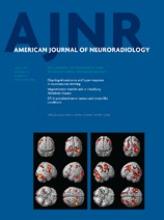Abstract
BACKGROUND AND PURPOSE: No highly specific MR imaging features distinguishing ISCMs from primary cord masses have been described. Our purpose was to retrospectively compare peripheral enhancement features on postgadolinium MR imaging of ISCMs with primary intramedullary cord masses.
MATERIALS AND METHODS: A consecutive group of patients with firmly diagnosed ISCM (45 patients with 64 ISCMs) and a comparison group with consecutive pathologically proved primary intramedullary spinal cord masses (64 patients with 64 primary spinal cord masses: ependymoma, astrocytoma, hemangioblastoma, ganglioglioma, and cavernous malformation) were included. MR images were evaluated for 2 specific signs on postgadolinium images: a “rim” sign (more intense thin rim of peripheral enhancement around an enhancing lesion) and “flame” sign (ill-defined flame-shaped region of enhancement at the superior/inferior lesion margins). The frequency of rim and/or flame signs in ISCMs and primary cord masses was compared (χ2 test). For ISCMs, the maximal dimension of the enhancing lesion was correlated with the presence of rim or flame signs (t test).
RESULTS: Rim and flame signs, alone and in combination, were seen more frequently in ISCMs than in primary cord masses (P < .0001 for each). Specificity and sensitivity, respectively, for diagnosing ISCMs among spinal cord masses on a per-patient basis were the following: rim sign, 97%, 47%; flame sign, 97%, 40%; at least 1 sign, 94%, 60%; and both signs concurrently, 100%, 27%. In the ISCM group, the presence of either a rim or flame sign correlated with a larger measured maximum enhancing lesion size (P = .0065 and P = .0012, respectively).
CONCLUSIONS: The rim and flame signs are common in and specific for ISCM and are rare in primary spinal cord masses.
ABBREVIATIONS:
- ABR
- American Board of Radiology
- ISCM
- intramedullary spinal cord metastasis
- WHO
- World Health Organization
- © 2013 by American Journal of Neuroradiology












